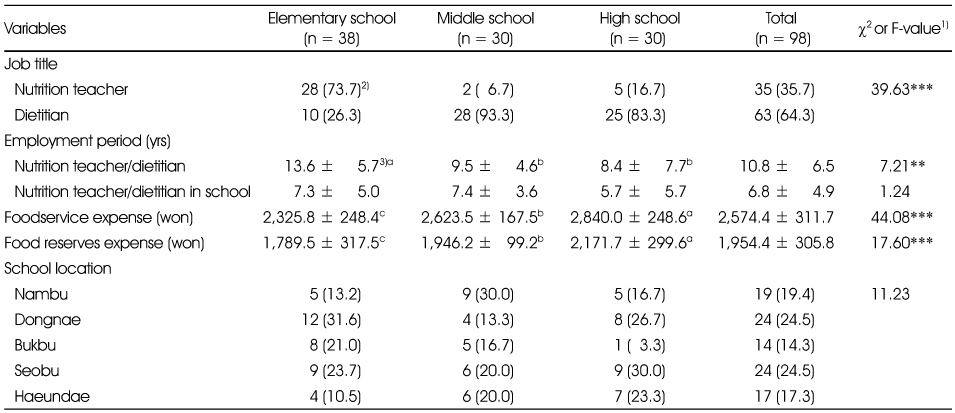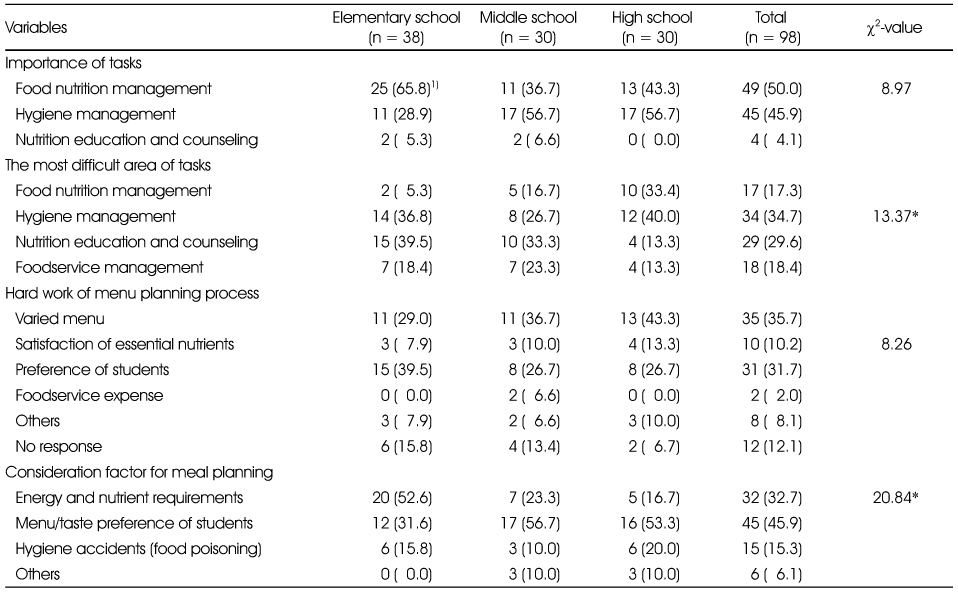Articles
- Page Path
- HOME > Korean J Community Nutr > Volume 19(2); 2014 > Article
-
Research Article
- The use Frequency and Amount of Food Sources of Sodium and Knowledge Requirement, and Job Satisfaction of Dietitians and Nutrition Teachers according to the School Types in Busan
- Jee-Young Yeon, Soon-Kyu Lee, Baeg-Won Kang
-
Korean Journal of Community Nutrition 2014;19(2):198-211.
DOI: https://doi.org/10.5720/kjcn.2014.19.2.198
Published online: April 30, 2014
Nutrition Safety Policy Division, Food Nutrition and Dietary Safety Bureau, Ministry of Food and Drug Safety, Cheongwon-gun, Chungcheongbuk-do, Korea.
- Corresponding author: Baeg-Won Kang. Nutrition Safety Policy Division, Food Nutrition and Dietary Safety Bureau, Ministry of Food and Drug Safety, Cheongwon-gun, Chungcheongbuk-do 363-700, Korea. Tel: (043) 719-2252, Fax: (043) 719-2250, gen0415@korea.kr
Copyright © 2014 The Korean Society of Community Nutrition
This is an Open-Access article distributed under the terms of the Creative Commons Attribution Non-Commercial License (http://creativecommons.org/licenses/by-nc/3.0/) which permits unrestricted non-commercial use, distribution, and reproduction in any medium, provided the original work is properly cited.
- 1,113 Views
- 1 Download
- 2 Crossref
Figure & Data
REFERENCES
Citations

- School Dietitian Awareness, Practice, and Sodium Reduction Plan in School Meal Service
Eun Kyung Kim, Hae Young Kim
Korean Journal of Food & Cookery Science.2016; 32(2): 222. CrossRef - Status and Need Assessment on Nutrition & Dietary Life Education among Nutrition Teachers in Elementary, Middle and High Schools
Na Gyeong Oh, Su Jin Gwon, Kyung Won Kim, Cheong Min Sohn, Hae Ryun Park, Jung Sook Seo
Korean Journal of Community Nutrition.2016; 21(2): 152. CrossRef
General characteristics according to the school types in Busan
1) Determined by independent sample F test of equality of the means or chi-square tests of differences in proportions
2) N (%)
3) Mean ± SD
abc: Means with different superscripts (a~c) within a row are significantly different from each at α = 0.05 by Duncan's multiple range test.
**: p < 0.01, ***: p < 0.001
Importance and the most difficult area according to the school types in Busan
1) N (%), *: p < 0.05
Recognition of school foodservice and processed food according to the school types in Busan
1) N (%)
**: p < 0.01, ***: p < 0.001
The amount, frequency and sodium content of sodium source according to the school types in Busan
1) Mean ± SD
abc: Means with different superscripts (a~c) within a row are significantly different from each at α = 0.05 by Duncan's multiple range test.
**: p < 0.01, ***: p < 0.001
Ranking of food sources by sodium content according to the school types in Busan
1) Cumulative percentage
The frequencies of dessert intakes and reasons for not providing fruits according to the school types in Busan
1) Mean ± SD
2) N (%)
abc: Means with different superscripts (a~c) within a row are significantly different from each at α = 0.05 by Duncan's multiple range test.
**: p < 0.01
Knowledge requirement according to the school types in Busan
1) Mean ± SD (A 5-point scale was used from 1: very unnecessary to 5: very necessary.)
abc: Means with different superscripts (a~c) within a row are significantly different from each at χ = 0.05 by Duncan's multiple range test.
*: p < 0.05, **: p < 0.01, ***: p < 0.001
Job satisfaction levels according to the school types in Busan
1) Mean ± SD
abc: Means with different superscripts (a~c) within a row are significantly different from each at α = 0.05 by Duncan's multiple range test.
*: p < 0.05, **: p < 0.01, ***: p < 0.001
Correlation coefficients between Knowledge requirement and Job satisfaction according to the school types in Busan
*: p < 0.05, **: p < 0.01, ***: p < 0.001
1) Determined by independent sample F test of equality of the means or chi-square tests of differences in proportions 2) N (%) 3) Mean ± SD abc: Means with different superscripts (a~c) within a row are significantly different from each at α = 0.05 by Duncan's multiple range test. **: p < 0.01, ***: p < 0.001
1) N (%), *: p < 0.05
1) N (%) **: p < 0.01, ***: p < 0.001
1) Mean ± SD abc: Means with different superscripts (a~c) within a row are significantly different from each at α = 0.05 by Duncan's multiple range test. **: p < 0.01, ***: p < 0.001
1) Cumulative percentage
1) Mean ± SD 2) N (%) abc: Means with different superscripts (a~c) within a row are significantly different from each at α = 0.05 by Duncan's multiple range test. **: p < 0.01
1) Mean ± SD (A 5-point scale was used from 1: very unnecessary to 5: very necessary.) abc: Means with different superscripts (a~c) within a row are significantly different from each at χ = 0.05 by Duncan's multiple range test. *: p < 0.05, **: p < 0.01, ***: p < 0.001
1) Mean ± SD abc: Means with different superscripts (a~c) within a row are significantly different from each at α = 0.05 by Duncan's multiple range test. *: p < 0.05, **: p < 0.01, ***: p < 0.001
*: p < 0.05, **: p < 0.01, ***: p < 0.001

 KSCN
KSCN









 Cite
Cite


